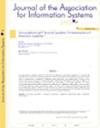The Effectiveness of Highlighting Different Communication Orientations in Promoting Mobile Communication Technology at Work vs. at Home: Evidence from a Field Experiment
IF 5.5
3区 管理学
Q1 COMPUTER SCIENCE, INFORMATION SYSTEMS
引用次数: 0
Abstract
With the development of mobile communication technologies, people can now engage in seamless communications with family members and coworkers at both home and work. When promoting a new mobile communication technology (e.g., the 5G network), firms may be tempted to emphasize how the technology can strengthen communication both within and across the two domains with the hope of improving purchase rates. Yet research has suggested that people may perceive mobile communication differently depending on whether those they are communicating with others who belong to the same domain. Thus, the promotion of the technology to potential users should perhaps consider users’ location domain and their communication targets. Through a field experiment, we show that when promoting mobile communication technology in the home domain, highlighting prevention-focused communication promotes greater purchase rates. However, at work, when coworkers are the target of communication, highlighting promotion-focused communication works better. These findings can not only help practitioners design more effective promotional messages in promoting mobile communication technologies but also contribute to the understanding of nuanced differences in the nature of mobile communication that make it more appealing to users in different within- and cross-domain communication scenarios.强调不同的通信取向在促进工作与家庭移动通信技术中的有效性:来自现场实验的证据
随着移动通信技术的发展,人们现在可以在家里和工作中与家人和同事进行无缝通信。在推广新的移动通信技术(例如5G网络)时,公司可能会倾向于强调该技术如何加强两个领域内部和跨领域的通信,以期提高购买率。然而,研究表明,人们对移动通信的看法可能会有所不同,这取决于他们是否与属于同一领域的人交流。因此,向潜在用户推广该技术也许应该考虑用户的位置域及其通信目标。通过现场实验表明,在家庭领域推广移动通信技术时,强调以预防为重点的通信可以促进更高的购买率。然而,在工作中,当同事是沟通的目标时,强调以促进为重点的沟通效果更好。这些发现不仅可以帮助从业者设计更有效的促销信息来推广移动通信技术,还有助于理解移动通信本质上的细微差异,使其在不同的域内和跨域通信场景中对用户更具吸引力。
本文章由计算机程序翻译,如有差异,请以英文原文为准。
求助全文
约1分钟内获得全文
求助全文
来源期刊

Journal of the Association for Information Systems
工程技术-计算机:信息系统
CiteScore
11.20
自引率
5.20%
发文量
33
审稿时长
>12 weeks
期刊介绍:
The Journal of the Association for Information Systems (JAIS), the flagship journal of the Association for Information Systems, publishes the highest quality scholarship in the field of information systems. It is inclusive in topics, level and unit of analysis, theory, method and philosophical and research approach, reflecting all aspects of Information Systems globally. The Journal promotes innovative, interesting and rigorously developed conceptual and empirical contributions and encourages theory based multi- or inter-disciplinary research.
 求助内容:
求助内容: 应助结果提醒方式:
应助结果提醒方式:


